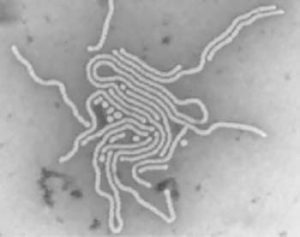 SR-BI, the receptor for high-density lipoprotein (HDL; “good cholesterol”) is one of the most sought after targets for treating metabolic diseases. Paul Dalhaimer’s research group shows that a soft, elongated poly-ethylene-oxide/poly-ethylene-glycol nanoparticle binds SR-BI. This opens the door for targeting applications, especially to macrophages and hepatocytes.
SR-BI, the receptor for high-density lipoprotein (HDL; “good cholesterol”) is one of the most sought after targets for treating metabolic diseases. Paul Dalhaimer’s research group shows that a soft, elongated poly-ethylene-oxide/poly-ethylene-glycol nanoparticle binds SR-BI. This opens the door for targeting applications, especially to macrophages and hepatocytes.
This research is published in the Journal of Controlled Release.
Synopsis
A significant fraction of the work in the field of nanomedicine is devoted to the use of nanoparticles (NPs) to treat diseases. The goal is for the NP to reach the target area in the body and impose a change in local physiology. Currently, NPs that are used in the clinic such as DOXIL are not targeted; thus, they have low specificity for target cells. However, the shell of DOXIL, which is composed of lipids and poly-ethylene-oxide (PEO) is relatively safe to mammals. To increase NP specificity for targets, ligands are usually chemically conjugated to the NP exterior. This is a fine strategy except it is costly, time-consuming, and unclear if these chemical modifications to the NP will produce an undesired affect in humans that will potentially be administered the NPs in the clinic. The challenge is to create biocompatible NPs out of chemistries like PEO that bind receptors with minimal chemical modification.
To this end, we show that elongated soft NPs (filomicelles) that are made from two benign polymers – PEO (FDA approved and currently used in the clinic on liposomes) and poly(butadiene) (biocompatible, very low toxicity in rodents) directly bind the main high-density lipoprotein (HDL, “good cholesterol”) receptor, scavenger receptor class B type I (SR-BI), on the surface of mammalian cells without chemical modification beyond the basic polymers listed above. Their affinity for SR-BI is a result of PEO – SR-BI interactions and the elongated geometry of the filomicelle. We show that single PEO molecules with lengths that are comparable to those on the surfaces of our NPs bind SR-BI, but the elongated shape of our NPs greatly increases this interaction through cooperativity. This is a huge boost for targeting SR-BI-expressing cells because it greatly reduces the complexity and cost of the chemistry and thus increases the practicality of the use of elongated PEO-based NPs in the clinic. Filomicelles also have excellent pharmacokinetic parameters including extended circulation times (Geng & Dalhaimer et al. Nat Nano 2007; Shuvaev et al. ACS Nano 2011). This allows them to have maximum localization to cells which have high expression levels of SR-BI. Understanding how SR-BI interacts with proteins and nanoparticles is particularly important given the role of SR-BI in cholesterol efflux and the recent findings that SAR-CoV-2 manipulates the SR-BI uptake pathway (Wei et al. Nat Metab 2020). Also, declined serum HDL-cholesterol is associated with the severity of COVID-19 infection (Hu et al. Clin Chim Acta 2020).
One additional, but major, finding of our work is that HDL lowers the uptake of filomicelles by the liver when both HDL and filomicelles are co-administered. Currently, one strategy for extending the circulation time of NPs is to kill liver resident macrophages – Kupffer cells – with clodronate liposomes prior to administration of the main NP (Tavares et al. PNAS 2017). Naturally this will compromise the immune system of the patient. Our strategy keeps the Kupffer cells viable but allows the NP to bypass their uptake for a myriad of applications. Thus, our findings have a broad impact on nanomedicine.